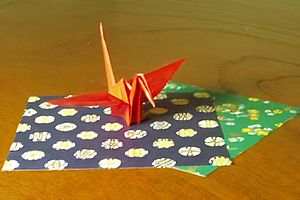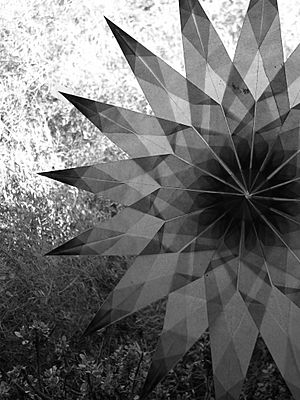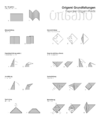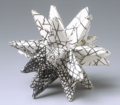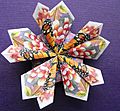Origami facts for kids
Origami is the amazing art of paper folding! The word "origami" comes from two Japanese words: ori, which means "folding," and kami, which means "paper." It's a fun way to create all sorts of shapes and objects just by folding paper, and it's a big part of Japanese culture.
Origami uses many different folding tricks to make cool things. You can use special origami paper, which is made to hold its shape well. While some people might think origami is only about paper cranes or airplanes, new folding techniques mean you can make many new models and creatures!
When origami first started in Japan, people usually used just one piece of paper. But there's also a type called modular origami. This uses many small, identical pieces of paper that are folded and then fit together to make one big model. You can even make complex math shapes with origami!
Contents
The History of Origami
The exact start of origami isn't completely clear, but paper folding began in China around the 1st or 2nd century. It then traveled to Japan in the 6th century. Early origami models didn't try to look exactly like real things; they just looked similar. People often folded models and gave them to others for good luck. For example, in Japan, noble families used origami butterflies to decorate sake glasses at weddings. These butterflies were meant to bring good luck to the bride and groom.
Paper folding traditions also grew in other places like Germany and Spain. One of the oldest examples of paper folding in Europe is a picture of a boat from 1490. There was also a paper box found from 1440. The first book about origami models, called Kan no mado, was written in 1845.
More recently, people around the world have become very interested in origami. In 1954, a Japanese paper folder named Akira Yoshizawa created a set of rules to explain how to fold origami models. His clear instructions are now used by origami artists everywhere.
What Do You Need for Origami?
Choosing the Right Paper
A famous paper folder named Peter Engel says that the best paper for origami is "thin and crisp and absolutely square." You can buy pre-cut origami paper in many colors, sizes, and patterns. Some paper, called "duo paper," has different colors on each side. This is great for models where you want different colored areas. There are also special papers with cool textures, metallic finishes, or unique patterns.
Many people also like to make their own special paper. One way is to make a "sandwich" of aluminum foil between two pieces of tissue paper. You simply paste two pieces of tissue paper onto each side of the aluminum foil. The great thing about origami is that you can almost always find paper to use! You can even use copy paper, napkins, wallpaper, index cards, or even paper money to make interesting and unique models.
Useful Origami Tools
Some paper folders like to work on a flat surface, but others, especially in Japan, prefer to fold in the air using only their hands. Traditional folders believe you should only use your hands. However, many modern folders use other tools. For example, tweezers and paper clips can help make very tiny or tricky folds. Some folders also use rulers or other flat tools to make super sharp creases in their models.
Different Types of Origami
As more people get into origami, new and exciting types of folding have been created!
Modular Origami
Modular origami is a type of origami where you fold several identical pieces of paper, called "modules." Then, you fit these modules together without glue to create a larger, often three-dimensional, structure. It's like building with paper!
Pureland Origami
Pureland origami has a special rule: you can only make one fold at a time. A British paper folder named John Smith created Pureland origami. It's perfect for people who are just starting out with origami or for those who might have trouble with very detailed hand movements. It makes origami simpler and more accessible.
Images for kids
-
A group of Japanese schoolchildren dedicate their contribution of Thousand origami cranes at the Sadako Sasaki memorial.
-
A stellated icosahedron made from custom papers.
-
Spring Into Action, designed by Jeff Beynon, made from a single rectangular piece of paper.
See also
 In Spanish: Origami para niños
In Spanish: Origami para niños


